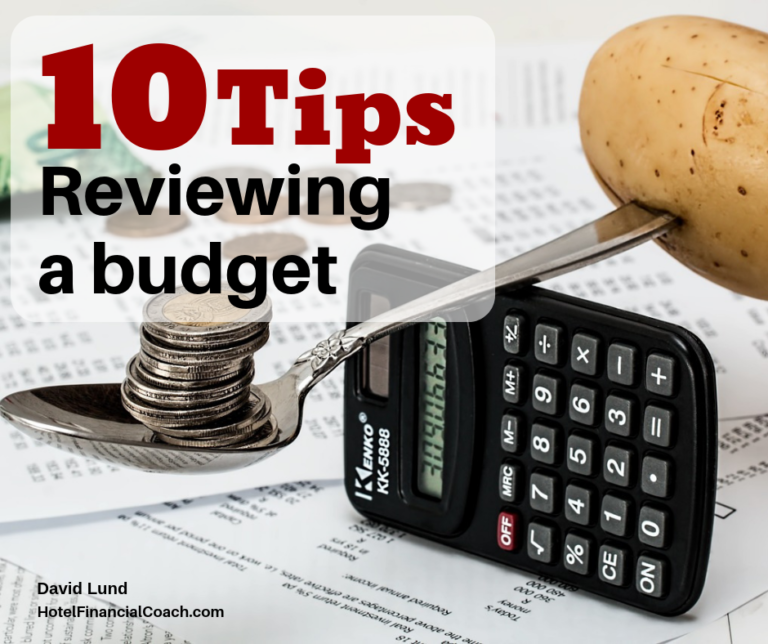
By David Lund
When you are reviewing a hotel budget you want to ask the right questions—the ones that will yield the biggest treasure.
You see, the game of budgets in most hotel companies where the corporate or regional master needs to approve the plan before it is presented to the owner, is a game of under promise now and hopefully over deliver next year. Some people I know call this the practice of sandbagging. It is not mean or deceitful, rather it is a game. If you are asleep at the switch when you are doing the review, well, that is your problem.
Operators are always looking for items they can keep in their back pocket for the rainy day ahead. In this business the smelly stuff flows uphill so to speak. That being said, the thinking is that it is important you leave some hidden treasure for the team or else your annual dividend could be compromised or at the very least reduced. Ask the right questions, find all the hidden gems, but leave something behind—just in case.
Back in the day during budget season we would review several budgets each day as we toured the continent or, some years, we had the hotels make the journey to headquarters. They lined up and we started shooting holes in what they put forward. Then the stories start
Caution: Be ready for several passionate tales of woe.
To help prepare my boss for these “stories” at the time, he would have me put together a cheat sheet for each review, so he knew what to ask. It was his job to know how far to push the hotel GM.
Sometimes the presenters would leave largely unscathed. Other times there was literally blood on the walls. Such fun.
Here are some of the more popular hiding spots and how to find them. But, remember the unwritten rules of the game. Play “catch and release” with most of your fish because you want them to be around next season.
1. Group rooms backlog. Where are you at YTD and what was the crossover point for the last three years? How many group contracts are sitting in tentative and prospect? What are the sellers doing to convert these to definite? Here you will be entertained by the sales chorus that usually sounds like: Customer lead time is being further reduced, more or new competition, fewer city-wides, sales manager attrition, rates are too high, meeting space needs renovating, bedrooms need renovating, national sales has dropped the lead-generating ball, and the best one that I heard was, the groups just are not coming next year!
2. Year-over-year P&L variance. Year-to-date revenues, YTD GOP, YTD flow thru vs. last year compared to year-end results on the same three measures. Do not gloss over on me here. This is the classic smoke and mirrors move that you need to be able to detect. Here is how it goes. Usually the budget gets reviewed by corporate in September or October. Analyze the YTD variance over last year in total revenue, GOP and flow thru. Then compare this to the Y End, full year-over-year projections. It often sounds like this song: Year-to-date September we are up $500K over last year in total revenues, GOP YTD is up $350K and the flow to last year is 70 percent. But, wait for it…. Y End shows the revenue variance has dropped to $300K and the GOP to $150K and the flow is now 50 percent. What will happen in the last three months of the year?
Answers range from: Last year we had a massive windfall that will not repeat, the business outlook for Oct, Nov and Dec are really bad, some other hotel in our comp set was renovating last year, or, the best one is, last year was just a great year! Do not fall for this vintage move. On the surface it may seem like too many moving parts but once you see it clearly you will not be fooled again. One last thing on this move is that it is the most common type of act you will see, and it still works wonders to fool the audience.
3. Year-over-year labor productivity performance. If you are reviewing a hotel budget, then by national averages half of the costs you are looking at are labor. If your budget does not include a productivity analysis, then you are reviewing the numbers with your eyes closed. What are the hours per room occupied and customer covers per hour of work this year compared to next year? The lower productivity number next year is what I want to see. If you are reviewing a labor budget and all you are looking at is dollars or percentages, you are being fooled. Ask for and insist on the hours of work in all departments and ask for and insist on the labor productivity analysis. I could fill the page. Check out my other article on labor productivity tools here.
4. An approved staffing guide. Insist on one being prepared each year to accompany the budget—a staffing guide that includes a complete list of all fixed (salaried positions) and a formula for all variable (scheduled positions). Make sure any new salaried positions are marked as such. Make sure any changes to the variable staffing formula produces better productivity. This is such a basic tool that many hotels operate without. Do not go into the swimming pool without yours!
5. Up-to-date STR report and a city- /region-wide marketplace supply and demand analysis. Flying without this tool is paramount to piloting your airplane at night without the proper instruments. Knowing how you are performing relative to your competitors is a daily, weekly and monthly mainstay in any hotel. The look beyond the comp set to the city/region with the same lens is a key measurement to ensure your property is properly positioned to gain share. If this is not happening then what are the alternatives, continue losing share, up your sales and marketing strategy or make your case to renovate? This is a powerful tool to get the right audience behind the bigger strategy for the property.
6. Zero-based expenses. How can you review or approve a budget for expenses without knowing the details of what you are looking at? Without zero-based expenses you are approving a cost-per-room occupied or a percentage of revenue approach. All you are doing is perpetuating the same lack of real accountability when it comes to what you spend on goods and services to look after your hotel. This really rears its ugly head when it is time to find money in the middle of the statement when volume or rates go backwards. Without a zero-based playbook for your expenses you do not know what to cut.
7. Fixed labor attrition. Every year you have management, administration and supervisory positions that are vacant for several reasons: maternity leave, recruiting a replacement, sitting on an open position for a few months, a tight labor market, time-to-fill the position. Do not get fooled into accepting a budget that has full staffing for salaried positions. Every year there is vacation, stat holidays and vacancies to take into account when budgeting this type of labor.
8. Don’t accept the status quo. This is an easy one to overlook. When someone wants to rubber stamp their efforts with the same result, do not accept it. Push back with a challenge. A good example is food cost. This year you are running at 28 percent and to the chef’s credit it is down from 28.25 percent last year. He naturally wants next year’s hurdle to be 28 percent again but do not accept it. Always look to add some challenge to everyone’s targets. Building into your annual plan a stretch for each measurement is what you want to do. Keep your managers on their toes. Do not accept the status quo.
9. What about the budget for incentives? You need to ensure the final financial budget includes a good measure of expense for the incentive plan. Especially if it is based on a profit target. If the target is the budgeted profit, then you must ensure the expenses to pay out—the incentive—is included in budgeted expense. Without it you have a hole that needs to be filled with additional expense and your team members will see that as a bait and switch by you.
10. Body count. Here is another example of where having and using EFTEs in your financials can be a great benefit. If all you are looking at with your budgeted payroll is dollars and percentages then you are getting the wool pulled over your eyes. What is the body count in each department? What is the split between management and hourly positions and most importantly – what is the body count creep factor? The most common want your managers have is they want more staff. It is human nature to throw bodies at problems. More staff rarely solves these challenges. Get your leaders to see that they can work with what they have.
The budget exercise is one that we commonly dislike because it is so long and people are often discouraged because they do not see their department getting more resources. They see the opposite – things are getting tighter and more challenging.
Set the stage and know where to look when you review your budgets!


